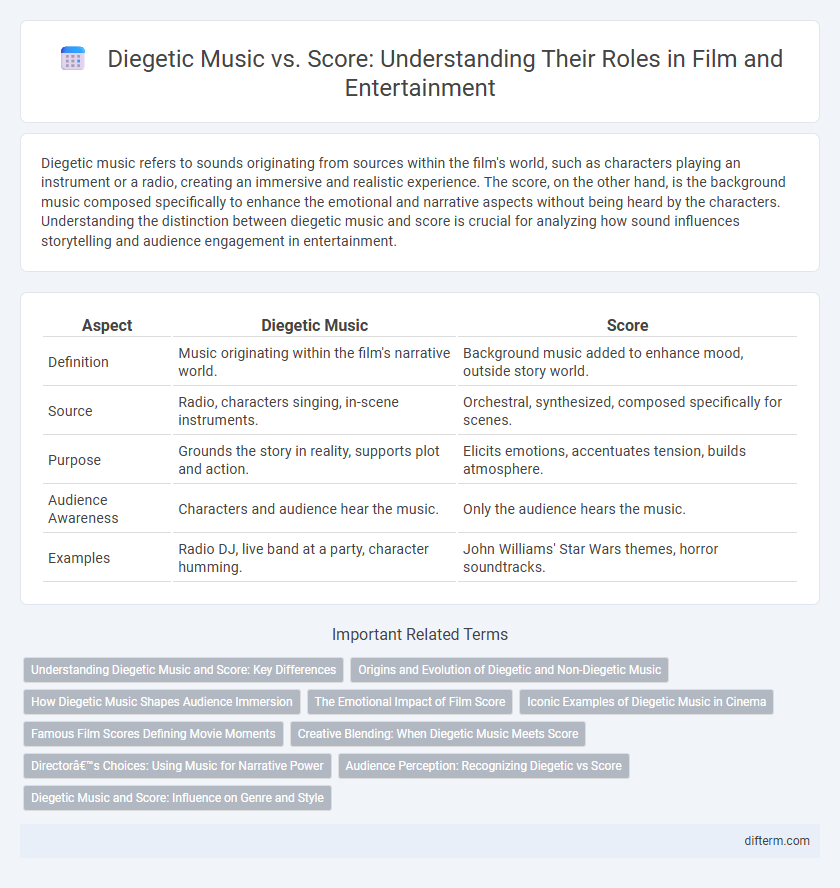Diegetic music refers to sounds originating from sources within the film's world, such as characters playing an instrument or a radio, creating an immersive and realistic experience. The score, on the other hand, is the background music composed specifically to enhance the emotional and narrative aspects without being heard by the characters. Understanding the distinction between diegetic music and score is crucial for analyzing how sound influences storytelling and audience engagement in entertainment.
Table of Comparison
| Aspect | Diegetic Music | Score |
|---|---|---|
| Definition | Music originating within the film's narrative world. | Background music added to enhance mood, outside story world. |
| Source | Radio, characters singing, in-scene instruments. | Orchestral, synthesized, composed specifically for scenes. |
| Purpose | Grounds the story in reality, supports plot and action. | Elicits emotions, accentuates tension, builds atmosphere. |
| Audience Awareness | Characters and audience hear the music. | Only the audience hears the music. |
| Examples | Radio DJ, live band at a party, character humming. | John Williams' Star Wars themes, horror soundtracks. |
Understanding Diegetic Music and Score: Key Differences
Diegetic music refers to music that originates within the world of the film, heard by both characters and the audience, such as a song playing on a character's radio, while a score is non-diegetic, composed specifically to enhance the emotional impact and atmosphere without being heard by the characters. Understanding diegetic music versus score is essential to analyzing how filmmakers create immersive storytelling and convey mood through auditory cues. The interplay between diegetic and non-diegetic elements shapes audience perception, driving narrative engagement and emotional resonance.
Origins and Evolution of Diegetic and Non-Diegetic Music
Diegetic music originates within the world of a film or show, emerging from sources visible or acknowledged by characters, often tracing back to early cinema where it grounded scenes in reality. Non-diegetic music, or the score, exists outside the narrative world, crafted to evoke emotions and direct audience perception, evolving through symphonic orchestration in silent films to contemporary digital compositions. The interplay of diegetic and non-diegetic music reflects a century-long evolution of cinematic storytelling techniques, enhancing immersion and emotional resonance.
How Diegetic Music Shapes Audience Immersion
Diegetic music, originating within the narrative world--such as a character playing a piano or a radio tune--anchors audiences by providing a tangible auditory source that enhances realism and emotional connection. This immersive effect contrasts with the non-diegetic score, which, while guiding emotional tone, remains external to the story world and thus less immediate. By integrating diegetic music, filmmakers deepen audience engagement through contextual sound cues that organically influence mood and character perception.
The Emotional Impact of Film Score
Film scores enhance emotional resonance by subtly guiding audience reactions through instrumental orchestration and thematic motifs. Unlike diegetic music, which originates within the story world and characters hear it, scores create an immersive atmosphere that intensifies suspense, joy, or sorrow beyond the visible action. Composers like John Williams and Hans Zimmer masterfully use scoring techniques to evoke deep psychological responses, making the narrative more compelling and memorable.
Iconic Examples of Diegetic Music in Cinema
Diegetic music in cinema refers to music that originates within the film's world, heard by characters and viewers alike, such as the unforgettable piano scene in "Casablanca" or the nightclub performance in "La La Land." These iconic examples vividly enhance narrative immersion by anchoring music to the story's reality, contrasting with the non-diegetic orchestral score that underscores emotions externally. Understanding the role of diegetic music helps filmmakers create a more authentic and emotionally resonant cinematic experience.
Famous Film Scores Defining Movie Moments
Famous film scores such as John Williams' "Star Wars" main theme and Hans Zimmer's "Inception" soundtrack create iconic movie moments by enhancing emotional depth through non-diegetic music, which exists outside the story world. Diegetic music, like the nightclub scene soundtrack in "Pulp Fiction," is part of the narrative environment, providing realism and character interaction. The contrast between diegetic and non-diegetic scores highlights how composers use sound to shape audience perception and strengthen storytelling.
Creative Blending: When Diegetic Music Meets Score
Creative blending of diegetic music and score enhances storytelling by merging on-screen sound sources with the underlying orchestral compositions, creating a seamless auditory experience. Films like "Inception" showcase this technique, where diegetic sounds transform into thematic motifs, deepening emotional resonance and narrative immersion. This integration allows composers and directors to manipulate mood and perspective dynamically, blurring the line between the characters' reality and the audience's perception.
Director’s Choices: Using Music for Narrative Power
Directors strategically employ diegetic music to enhance realism and immerse viewers within the story's environment, while non-diegetic score manipulates emotions and foreshadows plot developments. By contrasting diegetic sound sources--such as characters playing instruments or ambient music--with the orchestral or synthesized score, filmmakers create layers of narrative depth and guide audience interpretation. This dual usage of music amplifies storytelling impact, balancing authenticity with dramatic tension to reinforce thematic elements.
Audience Perception: Recognizing Diegetic vs Score
Diegetic music, heard by characters within a scene, grounds the audience in the film's reality, enhancing immersion and narrative continuity. Score, or non-diegetic music, operates externally, shaping emotional responses and guiding viewer interpretations without being acknowledged by characters. Audience perception hinges on this distinction, allowing viewers to differentiate between the story world's authentic soundscape and the film's orchestral or synthesized mood-setting elements.
Diegetic Music and Score: Influence on Genre and Style
Diegetic music, originating within the narrative world, enhances realism and character development by reflecting the cultural and temporal context of a film's genre, such as jazz in film noir or folk tunes in Westerns. A score, which exists outside the story space, manipulates audience emotions through thematic motifs and orchestration, often shaping the style of genres like epic fantasy or psychological thriller. The interplay between diegetic music and score creates a layered auditory experience that defines genre conventions and enriches cinematic storytelling.
Diegetic music vs Score Infographic

 difterm.com
difterm.com